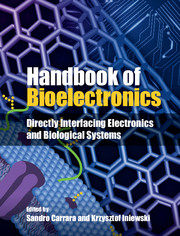Book contents
- Frontmatter
- Contents
- List of Contributors
- 1 What is bioelectronics?
- Part I Electronic components
- 2 Molecular components for electronics
- 3 Nanogaps and biomolecules
- 4 Organic thin-film transistors for biological applications
- 5 Protein-based transistors
- 6 Single-molecule bioelectronics
- 7 Nanoscale biomemory device composed of recombinant protein variants
- Part II Biosensors
- Part III Fuel cells
- Part IV Biomimetic systems
- Part V Bionics
- Part VI Brain interfaces
- Part VII Lab-on-a-chip
- Part VIII Future perspectives
- Index
- References
2 - Molecular components forelectronics
from Part I - Electronic components
Published online by Cambridge University Press: 05 September 2015
- Frontmatter
- Contents
- List of Contributors
- 1 What is bioelectronics?
- Part I Electronic components
- 2 Molecular components for electronics
- 3 Nanogaps and biomolecules
- 4 Organic thin-film transistors for biological applications
- 5 Protein-based transistors
- 6 Single-molecule bioelectronics
- 7 Nanoscale biomemory device composed of recombinant protein variants
- Part II Biosensors
- Part III Fuel cells
- Part IV Biomimetic systems
- Part V Bionics
- Part VI Brain interfaces
- Part VII Lab-on-a-chip
- Part VIII Future perspectives
- Index
- References
Summary
As stated in the previous chapter, Wolfgang Göpel wrote,“Bioelectronics is aimed at the direct coupling of biomolecularfunction units of high molecular weight and extremely complicated molecularstructure with electronic or optical transducer devices” [1]. Thestatement emphasizes two key points: the “direct coupling” andthe “high molecular weight”. This leads us now to developbioelectronic circuitries by moving from building blocks, or molecularcomponents, that involve high-molecular-weight biological molecules(typically proteins) by providing electrical contact at the nanoscale, inorder to address direct coupling. The first problem to solve is thereforethat of a nanoscale electrical contact.
During the last 15 years, several fabrication methods have been proposed toobtain a nanogap [2], based on the original work of Morpurgo etal. [3]. Among the possible solutions, a very effectivestrategy is to create an extremely tiny disconnection along a conductingwire in order to accommodate a biological molecule in between (Figure 2.1).The idea is to erode the electrical wire laterally in order to reduce itssize until one obtains a nanoscale conductor that becomes disconnected at acertain stage of the erosion. Morpurgo et al. [3]demonstrated that the wire’s conductivity becomes quantized in themoments immediately before the electrical connection breaks because thewavelength of the Schrödinger function associated with electronsbecomes comparable to the lateral size of the wire. We can therefore controlthe breaking of the connection by monitoring this quantum current. Now, wecan obtain a nanoscale interruption in the wire by stopping the erosionimmediately after the appearance of quantum states. If electrochemicaletching provides the erosion, then it is easy to control the process bymeans of a feedback system driven by the wire conductivity. Experimentalresults show that gaps can be obtained in the interrupted wire with sizesdown to 20 nm [3]. Considering now the typical size ofmetalloproteins, close to 5 nm [4], or of antibodies, up to15 nm [5], we can see that gaps of 20 nm are too large forquantum tunneling from the Fermi level in the metal to the LUMO (lowestunoccupied molecular orbital) in the protein [6].
Information
- Type
- Chapter
- Information
- Handbook of BioelectronicsDirectly Interfacing Electronics and Biological Systems, pp. 7 - 10Publisher: Cambridge University PressPrint publication year: 2015
